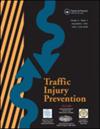Traffic conflict analysis in continuous confluence area of cross-river bridge driven by vehicle trajectory data
IF 1.6
3区 工程技术
Q3 PUBLIC, ENVIRONMENTAL & OCCUPATIONAL HEALTH
引用次数: 0
Abstract
Objectives
To conduct an in-depth study on the spatial distribution of traffic conflicts in the continuous merging areas of cross-river bridges and ensure public transportation safety.
Methods
First, we utilized drone aerial photography to collect videos of vehicle movements. Using the YOLOv7 object detection algorithm and the Strong SORT multi-object tracking algorithm, we extracted high-precision vehicle trajectory time-series data. Next, based on the motion characteristics of traffic entities, we proposed using Deceleration Rate (DR) to describe rear-end conflicts and Lane Change Speed (LCS) to describe lane-changing conflicts. Additionally, we employed the K-means clustering method to determine the threshold values for minor, moderate, and severe levels of rear-end and lane-changing conflicts. Finally, based on the obtained trajectory data, the values of traffic conflicts are calculated and their severity is classified. A heat map of the spatial distribution of vehicle conflicts in continuous merging zones is then created to study the spatial distribution patterns of traffic conflicts.
Results
The threshold values for minor, moderate, and severe levels of rear-end conflicts are determined to be 3.06 m/s2, 5.36 m/s2, and 8.04 m/s2, respectively. For lane-changing conflicts, the thresholds are 1.13 m/s, 2.07 m/s, and 3.45 m/s. The spatial distribution of traffic conflicts exhibits a “first increase, then decrease, and then increase again” trend.
Conclusions
The study identifies the critical areas of traffic conflicts in the continuous merging zones of cross-river bridges. The research results provide a novel approach for acquiring traffic data in these areas and offer a reliable quantitative method for assessing safety risks on these road segments. This provides a theoretical basis for proposing targeted traffic safety management strategies.
基于车辆轨迹数据的跨江大桥连续汇流区交通冲突分析。
目的:深入研究跨江大桥连续合流区交通冲突的空间分布,确保公共交通安全:深入研究跨江大桥连续合流区交通冲突的空间分布,确保公共交通安全:首先,我们利用无人机航拍采集车辆行驶视频。方法:首先,利用无人机航拍采集车辆运动视频,利用 YOLOv7 目标检测算法和 Strong SORT 多目标跟踪算法,提取高精度的车辆运动轨迹时间序列数据。接下来,根据交通实体的运动特征,我们提出使用减速率(DR)来描述追尾冲突,使用变道速度(LCS)来描述变道冲突。此外,我们还采用 K-means 聚类方法确定了轻微、中度和严重程度的追尾和变道冲突阈值。最后,根据获得的轨迹数据,计算交通冲突值并对其严重程度进行分类。然后绘制连续并线区域车辆冲突空间分布热图,以研究交通冲突的空间分布模式:结果:轻微、中度和严重追尾冲突的临界值分别为 3.06 m/s2、5.36 m/s2 和 8.04 m/s2。对于变道冲突,阈值分别为 1.13 m/s、2.07 m/s 和 3.45 m/s。交通冲突的空间分布呈现出 "先增加、后减少、再增加 "的趋势:该研究确定了跨江大桥连续合流区交通冲突的关键区域。研究成果为获取这些区域的交通数据提供了一种新方法,并为评估这些路段的安全风险提供了一种可靠的定量方法。这为提出有针对性的交通安全管理策略提供了理论依据。
本文章由计算机程序翻译,如有差异,请以英文原文为准。
求助全文
约1分钟内获得全文
求助全文
来源期刊

Traffic Injury Prevention
PUBLIC, ENVIRONMENTAL & OCCUPATIONAL HEALTH-
CiteScore
3.60
自引率
10.00%
发文量
137
审稿时长
3 months
期刊介绍:
The purpose of Traffic Injury Prevention is to bridge the disciplines of medicine, engineering, public health and traffic safety in order to foster the science of traffic injury prevention. The archival journal focuses on research, interventions and evaluations within the areas of traffic safety, crash causation, injury prevention and treatment.
General topics within the journal''s scope are driver behavior, road infrastructure, emerging crash avoidance technologies, crash and injury epidemiology, alcohol and drugs, impact injury biomechanics, vehicle crashworthiness, occupant restraints, pedestrian safety, evaluation of interventions, economic consequences and emergency and clinical care with specific application to traffic injury prevention. The journal includes full length papers, review articles, case studies, brief technical notes and commentaries.
 求助内容:
求助内容: 应助结果提醒方式:
应助结果提醒方式:


